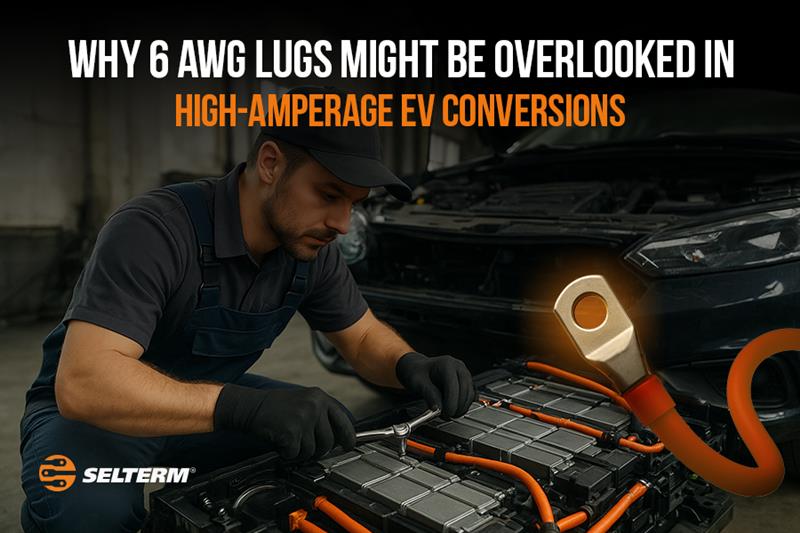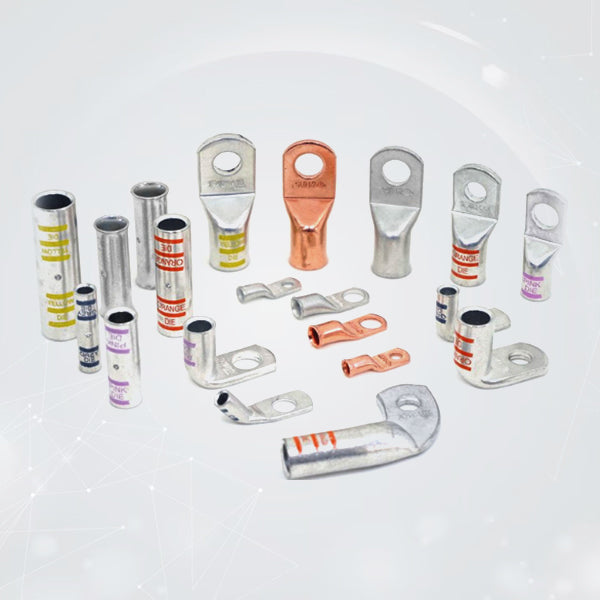
Why 6 AWG Lugs Might Be Overlooked In High-Amperage EV Conversions
Electric vehicle (EV) conversions are no longer just a hobbyist experiment; they’ve become a growing movement among car builders, restorers, and DIY enthusiasts. From classic cars getting an electric heart to utility vehicles repurposed for clean energy, conversions are unlocking new ways to rethink transportation. But while most of the attention in these builds goes toward motor selection, battery packs, and controllers, there’s one detail often underestimated: the connectors.
Specifically, 6 AWG lugs, small yet essential components that keep high-current wiring secure and reliable. In the race to handle ever-higher amperage demands, these lugs are sometimes overlooked in favor of larger gauge solutions. There are many parts in an EV conversion where 6 gauge wire lugs, or simply sometimes referred to as 6 AWG lugs, or 6 AWG cable lugs, or 6 AWG ring lugs are still open for business! Let’s explore why they matter, when they’re the right choice, and how ignoring them can affect both performance and safety.
The Growing Demands Of EV Conversions
EV systems are naturally power-hungry. Motors and controllers can demand hundreds of amps under load, so heavy cables and connectors are not optional. Many builders will use oversize cabling, such as 2 AWG or possibly larger, even to main battery connections. When considering the high-amperage paths this makes sense, but it also leads people to overlook smaller alternatives such as 6 AWG cable lugs.
But not every connection in a vehicle requires massive cabling. Auxiliary systems, intermediate circuits, and certain power distribution lines often operate within current ranges that suit 6 AWG perfectly. Overbuilding in these areas doesn’t just add cost, it can make wiring less flexible and harder to manage.
Why 6 AWG Lugs Get Overlooked
There are a few reasons why these lugs don’t always get the attention they deserve:
- Focus on Maximum Amps: Builders tend to size everything for worst-case loads, assuming bigger is always better.
- Fear of Undersizing: The risk of overheating or voltage drop leads many to overcompensate with larger cables and lugs.
- Visibility Bias: Because 6 AWG looks small compared to hefty battery cables, it’s easy to assume it isn’t up to the task in EV systems.
- Lack of Clear Guidance: Conversion projects often rely on a mix of manufacturer specs and community advice, where recommendations can lean toward overkill.
The result? Useful, efficient solutions like 6 AWG ring lugs often get sidelined, even in areas where they’re the perfect fit.
Where 6 AWG Still Shines In EV Builds
Despite being overshadowed, 6 AWG connectors continue to serve vital functions:
- Battery Management Systems (BMS): Many BMS connections and monitoring circuits don’t carry the same current as main drive systems but still require secure lugs.
- Auxiliary Systems: Cooling pumps, heaters, DC-DC converters, and onboard chargers are usually within current ranges compatible with 6 gauge wire lugs.
- Mid-Power Distribution: Circuits that do not require maximum drive amperage but do require reliability are well suited to 6 AWG wire's balance of size and strength.
- Tight Spaces: In constrained engine compartments or retrofits, large cabling can create hassles. A well selected 6 AWG lug can present a manageable solution while maintaining a safe operation.
Once a builder carefully matched the lug size with the load, they could then eliminate the cumbersome overbuilt wiring and ensure they meet a durable solution.
The Risks Of Overlooking Proper Lug Sizing
Skipping over 6 AWG in favor of only larger options doesn’t just add unnecessary bulk, it can introduce real drawbacks:
- Flexibility Issues: Large-gauge wires are harder to route, bend, and secure in compact EV conversions.
- Higher Costs: Bigger lugs and cables add up quickly, especially across an entire build.
- Voltage Drop from Mismatched Parts: Using a lug that doesn’t properly fit its wire size creates poor contact points and higher resistance.
- Overheating Risk: Underrated or poorly installed connectors are a common cause of failures in EV builds, and bigger doesn’t always mean safer.
By giving the right attention to 6 AWG cable lugs, builders strike the balance between capacity and practicality.
Tips for Choosing and Installing 6 AWG Lugs
If you’re considering 6 AWG for parts of your EV conversion, here’s what to keep in mind:
- Match Wire to Lug Size: Always ensure the lug is designed for 6 AWG wire. A loose fit compromises conductivity.
- Material Quality: Choose pure copper or tinned copper for maximum conductivity and corrosion resistance.
- Crimping Tools Matter: Invest in a proper crimping tool for consistent, solid connections, pliers won’t cut it.
- Use Heat Shrink Tubing: Protect connections from vibration, moisture, and oxidation.
- Check Load Ratings: Before committing to 6 AWG, confirm the expected current is within its safe range for the application.
Final Thoughts
In the world of EV conversions, the details matter. Quality and attention to detail are the difference between a safe and efficient build and one that is riddled with needless problems. 6 AWG lugs may not be the spotlight of your conversion like big battery cables, but you will need them in multiple parts of a high-amperage system. Adding circuits to auxiliary systems, power distribution to secondary components, a correctly executed 6 AWG wire lug or 6 AWG ring lug can provide a professional connection at a relatively low cost without excessive space usage.
Before defaulting to oversized hardware, take a closer look at where 6 AWG fits into your project. Explore Selterm’s range of precision-engineered 6 AWG cable lugs to build connections that balance safety, efficiency, and practicality, because in EV conversions, even the overlooked details power the bigger picture.

